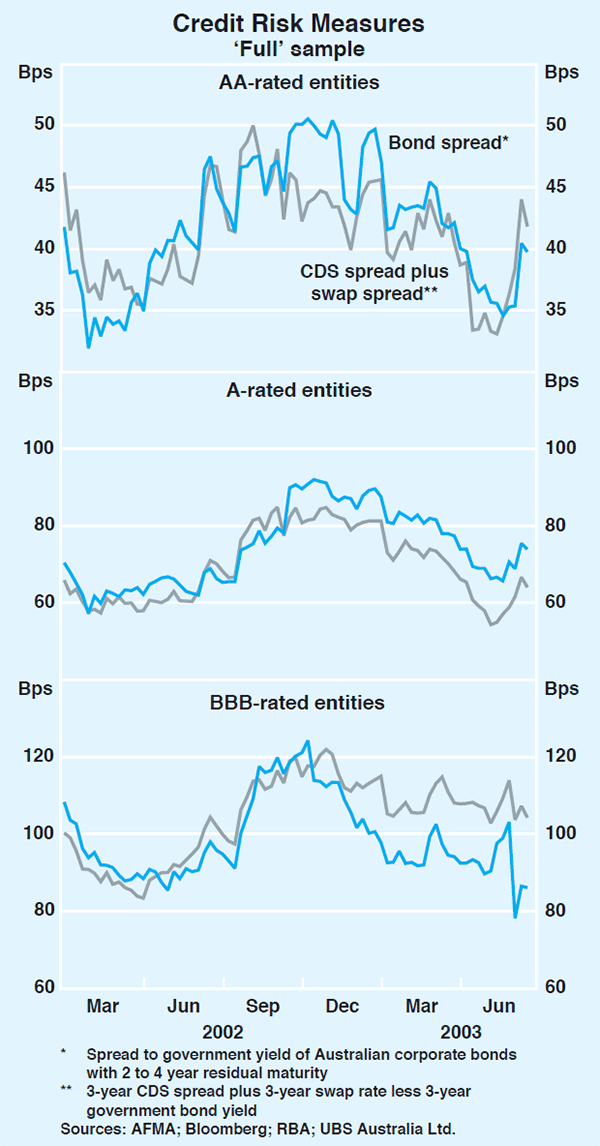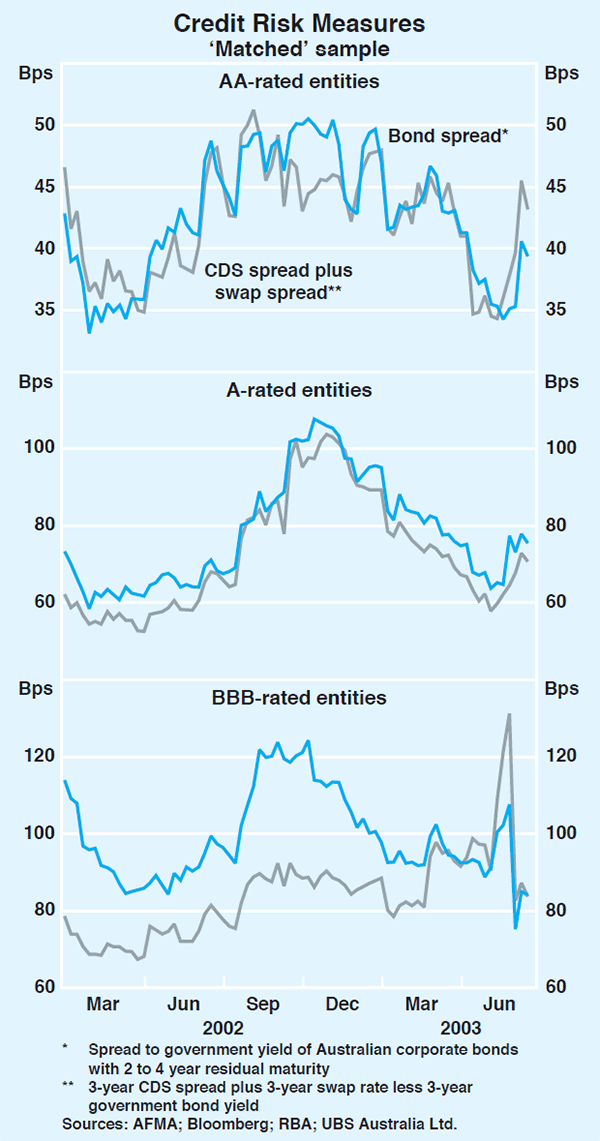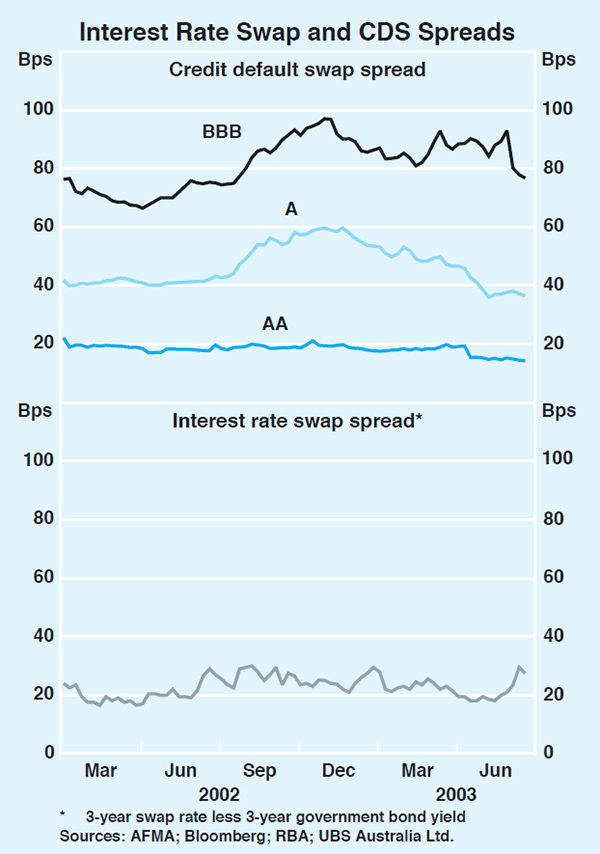Bulletin – July 2003 New Measures of Credit Risk
- Download 57KB
An article in the May issue of the Bulletin analysed the growth of credit risk transfer markets.[1] In this article we build on that work, explaining how these markets, in particular the market for credit default swaps, can provide new measures of credit risk.[2]
A Re-cap
As discussed in the May Bulletin article, the main derivative instrument traded in the credit risk transfer markets is the credit default swap (CDS). This is a bilateral contract, usually between two financial institutions, in which one agrees to compensate the other in the event that a nominated third party experiences a credit event, such as bankruptcy. If a credit event does occur during the term of the CDS, the entity providing compensation typically pays the other party the pre-agreed notional amount of the swap. In exchange, the protection buyer gives the entity providing the compensation a debt obligation (usually a bond) issued by the third party.
The key elements of a CDS are:
- the protection buyer – the party looking to protect itself against credit risk;
- the protection seller – the party offering to provide the protection;
- the reference entity – the third party whose credit worthiness is the key determinant of the CDS's value; and
- the premium (also known as the CDS spread) – the amount paid by the protection buyer to the protection seller.
It is this last aspect of a CDS that is the focus of this article. No upfront payment is made by either party when establishing a CDS. Instead the protection seller is paid a premium at regular intervals over the life of the swap. Recently, for example, the premium for a 5-year CDS on A-rated Australian entities has averaged around 45 cents per year per $100 protected – i.e. 45 basis points. The premiums at which CDS are traded provide information on the market's assessment of credit risk, and hence the market's willingness to supply credit.
Measures of Credit Risk
Until recently, the main source of market-based information on credit risk has been the corporate bond market. The margin between the yield on corporate bonds and that on government bonds has typically been used to measure credit risk. These margins tend to vary with the credit rating of the borrower and the term to maturity of the bond. The lower the credit rating and the longer the term to maturity, the higher the credit spread tends to be, since both characteristics increase the chance of default. As well as spreads on individual securities, information is available on average credit spreads for given credit ratings.
While aggregate bond spreads are clearly useful measures of credit risk, their construction poses a number of difficulties. Perhaps the main one in Australia is that the number of bonds available for inclusion in an index can be quite small. In constructing an index, bonds of a similar maturity need to be used, given credit spreads' tendency to increase with a bond's term to maturity. The measures used by the Reserve Bank, for example, are based on bonds with a maturity of 2 to 4 years. This restriction limits the number of available bonds from an already rather small sample. It also means that the bonds included in the aggregate measure change through time as bonds move out of, or into, the relevant maturity window.
A second problem is that it can be difficult to align the maturities of the relevant corporate and government bonds. Often, there is no government bond with exactly the same maturity as that of the private-sector bond. As a result, a risk-free rate for the relevant maturity must be interpolated. In some cases, adjustments also need to be made for differences in the size and/or timing of the coupon payments on the private and government bonds.
A third difficulty is that private and government bonds may have different legal structures. For example, while rare in the Australian market, in overseas markets it is not uncommon for a privately issued bond to have some form of call option (i.e. the issuer has the right to buy back the bond). The prices of bonds that include such an option tend to be more sensitive to changes in the issuer's credit quality. More prevalent in the Australian market is the practice of issuing bonds with third-party credit enhancement (known as credit wrapping). Credit wrapping provides a buffer between the credit risk of the bond issuer and the bond itself. Bond spreads on credit-wrapped bonds, therefore, tend to reflect the market's view of the credit risk of the credit enhancement provider rather than that of the bond issuer.
While these difficulties do not invalidate measures of credit risk calculated from bond spreads, CDS provide a useful complement. CDS possess three main advantages. First, unlike bond spreads, a relatively constant sample of companies can be used through time, given that CDS spreads are quoted for fixed maturities. Second, CDS can help overcome the difficulties posed by credit wrapping since CDS typically focus on the underlying issuer rather than the credit-enhancement provider. When a credit event occurs, credit protection buyers will seek to maximise the value of their CDS by delivering a bond without credit wrapping to the protection provider. As a result, provided the reference entity has a sufficient amount of unwrapped bonds on issue, CDS are likely to be priced against those bonds rather than credit-wrapped bonds. Third, instead of adjusting CDS spreads for the relevant government bond rate, CDS spreads are priced relative to rates on interest rate swaps. Since both CDS spreads and swap rates are available for fixed maturities, CDS can provide a clearer view of the credit-risk term structure.
Compositional effects
Data published on bond spreads tend to be market-wide measures based on all bonds on issue of relevant maturity and credit rating. These are likely to cover a different group of companies from those for which CDS spreads are available. As such, differences can emerge between market-wide measures of credit risk based on corporate bond spreads and CDS spreads. Further, while the sample of companies for which CDS spreads are available tend to be stable, those included in bond-spread indices tend to vary depending on which companies have relevant bonds on issue. As such, not only will there be differences between market-wide measures of credit risk derived from bond spreads and CDS spreads, but those differences may change over time.
The effects of changes in the composition of the bond-spread indices can be seen in Graph 1, which shows, for each ratings category, the average bond spread for all 2- to 4-year corporate bonds and the average 3-year CDS credit risk measure for all reference entities for whom reference rates are published by the Australian Financial Markets Association. While the credit measures for AA-rated companies have been largely immune from compositional effects, those for A-rated companies and BBB-rated companies have not. For example, the large increase in the bond spread index for A-rated companies observed in September 2002 was largely attributable to compositional changes. In particular, a number of companies with low bond spreads moved out of the 2- to 4-year window. On 17 September 2002 eight bonds were removed from the index due to their residual maturity declining to less than 2 years. The effect of this change in composition was to increase the aggregate credit spread by 10 basis points. Using CDS prices for a constant sample of companies suggests little rise in credit risk in the second half of September 2002.[3]

Arbitrage between the bond and CDS markets
In principle, bond-based measures of credit risk, for a given company, should behave similarly to measures obtained from CDS. Broadly speaking, the CDS spread plus the fixed rate on an interest rate swap corresponding to the maturity of the CDS should equal the yield on a (hypothetical) bond issued by the company of the same maturity. Arbitrage between the corporate bond market and the CDS market should promote such an outcome.[4]
Even when considering the same companies, however, two factors can lead to differences in credit-risk measures derived from CDS spreads and bond yields. The first is that the maturity of the CDS and the available bonds on issue may be different. The second is that CDS protection buyers face the risk that the protection seller may default; bond transactions are free from such risk. The effect of these two factors will vary through time and, a priori, it is difficult to say whether one will dominate.
That the arbitrage relationship generally holds in practice can be seen in Graph 2, which shows, for each ratings category, the average bond spread for companies for which 3-year CDS spreads are available. It also shows the average 3-year CDS spread plus the spread between the interest rate swap rate and the government bond rate for the same companies.[5] The two measures, therefore, reflect the risk premium over government bond rates for each ratings category. The number of companies changes through time as bonds move through the 2- to 4-year window, but at each point in time the same companies are included in the bond- and CDS-based measures for each ratings category.

In the case of companies rated either AA or A, the bond- and swap-based measures are very similar, both in terms of levels and in changes through time. In particular, both measures rose over the second half of 2002 before declining over the first half of this year. When comparing a common group of BBB-rated companies, however, there was a marked gap between the two measures of credit risk up until March 2003. In part this reflected the fact that the average term to maturity of the BBB bonds was at the longer end of the 2- to 4-year band during 2002, which tended to lift the bond spread. It may also have reflected pricing anomalies in what is still a relatively new market.
Comparing the CDS spread and the interest rate swap spread
In the case of the CDS-based credit risk measures for companies rated A and BBB, most of the variation in the risk measure through time is attributable to movements in average CDS spreads rather than to movements in the difference between the swap and the government bond rates (Graph 3). For AA-rated companies, however, the reverse is the case. Three-year CDS spreads for AA-rated reference entities have fluctuated in a narrow range between 15 and 20 basis points over most of the past year. The stability in the AA CDS spreads reflects the fact that the interest rate swap rate incorporates AA credit risk, as interest rate swap rates reflect the credit worthiness of the main bank-bill issuers, which tend to be AA-rated banks.

Conclusion
While the Australian CDS market remains in the early stages of development, credit-risk measures based on CDS spreads provide a useful supplement to those derived from bond prices. In particular, CDS spreads offer the advantage of providing a market-wide risk measure based on a relatively constant group of borrowers free from the effects of changes in bonds' maturities through time. The Reserve Bank began publishing data on corporate bond spreads in June 2001. This month, the Bank is supplementing those data by adding CDS spreads to the series shown in Bulletin Table F.3.
Footnotes
See ‘Credit Risk Transfer Markets: An Australian Perspective’, Reserve Bank of Australia Bulletin, May 2003, pp 55–62. [1]
This article was prepared by Ivailo Arsov and Marianne Gizycki, Domestic Markets Department. [2]
The gap between the bond- and CDS-based credit risk measures for AA-rated companies that opened up at around the same time reflects differences in pricing of the same companies in the two markets rather than compositional effects. [3]
For a more detailed discussion of CDS pricing, see Duffie D (1999), ‘Credit swap valuation’, Financial Analysts Journal, 55(1), pp 73–87. [4]
The bond spread indices in this and all following graphs are calculated as weighted averages, with the weights based on each bond's face value. The CDS indices are simple, unweighted averages of individual reference entities' swap spreads. Using unweighted averages of bond spreads does not materially alter the relativities between the bond- and CDS-based risk measures. [5]